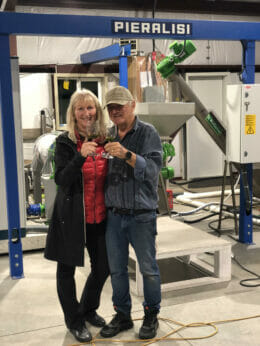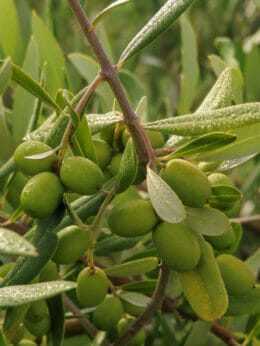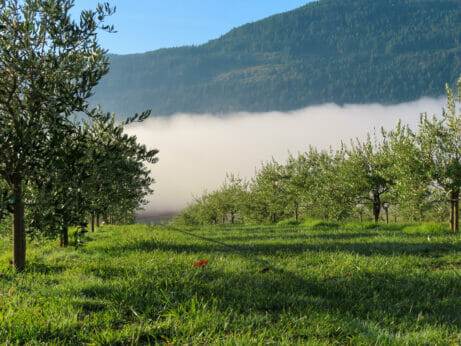The Hot and Cold of Growing Olives in Canada
As damaging heat waves become more frequent, the Pacific Northwest provides hope for adventurous olive growers willing to take a risk.
The Hot and Cold of Growing Olives in Canada
As damaging heat waves become more frequent, the Pacific Northwest provides hope for adventurous olive growers willing to take a risk.

Picking olives in the Braun's British Columbia groves.courtesy of The Olive Farm
It was early December 2016, and the first real cold of the season was descending upon Salt Spring Island, British Columbia and The Olive Farm’s 72 acres was a flurry of activity. Sheri and George Braun, the grove’s owners, had waited until the last possible moment before the onslaught of winter weather to make sure the olives had fully ripened. Now, with family and friends helping out, they were fervently picking the ripe green fruit.
Eventually, they would bottle eight and a half gallons of extra virgin olive oil, the first commercial-grade olive oil produced in Canada. It wasn’t a lot. Olive trees are slow growers, taking at least four years to produce fruit. Many of the trees on the Brauns’ property were still maturing, only just reaching their fourth birthday, and still too young to produce fruit. But, despite the low yield, it was enough to give the Brauns the inspiration they needed.

Other than the hobbyist who plants a few trees in their garden or patio pots, olive farming has traditionally been considered ill suited for Canada’s unpredictable cold weather. But, with heat intensifying in traditional olive-growing regions around the world, places such as Oregon and the microclimate of British Columbia’s Gulf Islands have become unlikely olive oil hubs.
Since 2020, the olive-producing regions of northern California have experienced increasingly intense heat in the low hundreds. Heat waves have also accelerated in Europe over the past several decades. Spain produces 57% of the world’s olive oil, and this past April, just as the olive trees were in blossom, temperatures in many regions soared.
The Brauns are in a sweet spot of west-coast geography. Salt Spring Island is part of a larger archipelago of islands between the mainland of southern British Columbia and Vancouver Island. The warming currents of the Pacific Ocean meet the Salish Sea and create a rain-shadow effect and moderate temperatures encompassing the region. The climate is often compared to the olive-producing regions of northern Italy, Portugal or Spain.

Michael Pierce operates Saturna Olive Consortium on neighbouring Saturna Island. He imports olive trees and sells them to local hobbyists. Despite the mild climate and an increase of frost-free days in British Columbia (a whopping three weeks since the middle of the last century), Pierce cautions that “growing olives in British Columbia is not for the risk averse.”
The sentiment is echoed by Lenore Newman, director of the Food and Agricultural Institute of the University of the Fraser Valley. “Climate change is making the average [temperature] warmer, but we are more likely to get erratic weather that includes deep arctic outbursts that are too cold for olive trees in most areas.”
Olive trees are sensitive. Ideally, they should be planted on a south-facing slope with well-draining soil to wick water away. If the roots get water-logged, they may not survive. Never truly dormant, they need periods of chill to tell them to stop producing for the season, but not too cold. Young trees are only able to withstand temperatures as low as 10 degrees F (-12 degrees Celsius). It’s intense heat, though, that may be their worst enemy. Although olive trees like warmth, they also have their limits, as many varieties are only able to tolerate temperatures to a maximum of 104 degrees F.

Despite The Olive Farm’s prime location, southern sloped exposure and the Brauns’ careful selection of cold-hardy varieties of olive trees (Leccino, Maurino and Frantoio), they’ve experienced challenges.
“It’s a really good thing we didn’t know what we know now when we bought the property in 2010, or we wouldn’t have embarked upon the project,” Sheri jokes. After planting their first trees in 2012, the couple had to wait four agonizing years to see if any would produce fruit. If that wasn’t hard enough, in November 2021, atmospheric rivers of rain pummelled British Columbia’s south coast. The Brauns lost 10 percent of their 3,000-tree grove. In late June 2021, just as their trees were blooming, a massive heat dome stretched from California into northern British Columbia, lasting almost a week.
“The trees survived, but the flowers withered,” says Sheri. Without flowers, there’s no fruit.
That alone might have been enough for some to throw in the towel, but a previous visit to an olive grove in Oregon State kept them motivated. Western Oregon has warm arid summers and mild wet winters—not dissimilar to Salt Spring.
Here, too, it’s getting hotter. According to a January 2023 report by Oregon State University’s Climate Change Institute, average temperatures in the state have increased by 2.2 degrees F since 1895 and are projected to increase by 5 degrees F by the 2050s and 8.2 degrees F by the 2080s.
Chris Barry is the agricultural manager of River Ranch Olive Farm, located in the southwestern corner of Oregon. River Ranch’s secret, much like The Olive Farm, is the micro-climate created by the gentle breezes of the North Umpqua River bordering the olive grove, which keeps the temperatures stable. “It takes determination to grow olives in this climate,” he says. “If the rain comes and the ground freezes, the trees are goners, especially the younger ones.”
On Salt Spring Island, the Brauns’ determination to grow olives has paid off. Their best harvest to date was in 2022, when the grove produced 89.5 gallons of Canadian extra virgin olive oil.
“We’re committed now,” says Sheri.
Follow us

This work is licensed under a Creative Commons Attribution-NoDerivatives 4.0 International License.
Want to republish a Modern Farmer story?
We are happy for Modern Farmer stories to be shared, and encourage you to republish our articles for your audience. When doing so, we ask that you follow these guidelines:
Please credit us and our writers
For the author byline, please use “Author Name, Modern Farmer.” At the top of our stories, if on the web, please include this text and link: “This story was originally published by Modern Farmer.”
Please make sure to include a link back to either our home page or the article URL.
At the bottom of the story, please include the following text:
“Modern Farmer is a nonprofit initiative dedicated to raising awareness and catalyzing action at the intersection of food, agriculture, and society. Read more at <link>Modern Farmer</link>.”
Use our widget
We’d like to be able to track our stories, so we ask that if you republish our content, you do so using our widget (located on the left hand side of the article). The HTML code has a built-in tracker that tells us the data and domain where the story was published, as well as view counts.
Check the image requirements
It’s your responsibility to confirm you're licensed to republish images in our articles. Some images, such as those from commercial providers, don't allow their images to be republished without permission or payment. Copyright terms are generally listed in the image caption and attribution. You are welcome to omit our images or substitute with your own. Charts and interactive graphics follow the same rules.
Don’t change too much. Or, ask us first.
Articles must be republished in their entirety. It’s okay to change references to time (“today” to “yesterday”) or location (“Iowa City, IA” to “here”). But please keep everything else the same.
If you feel strongly that a more material edit needs to be made, get in touch with us at [email protected]. We’re happy to discuss it with the original author, but we must have prior approval for changes before publication.
Special cases
Extracts. You may run the first few lines or paragraphs of the article and then say: “Read the full article at Modern Farmer” with a link back to the original article.
Quotes. You may quote authors provided you include a link back to the article URL.
Translations. These require writer approval. To inquire about translation of a Modern Farmer article, contact us at [email protected]
Signed consent / copyright release forms. These are not required, provided you are following these guidelines.
Print. Articles can be republished in print under these same rules, with the exception that you do not need to include the links.
Tag us
When sharing the story on social media, please tag us using the following: - Twitter (@ModFarm) - Facebook (@ModernFarmerMedia) - Instagram (@modfarm)
Use our content respectfully
Modern Farmer is a nonprofit and as such we share our content for free and in good faith in order to reach new audiences. Respectfully,
No selling ads against our stories. It’s okay to put our stories on pages with ads.
Don’t republish our material wholesale, or automatically; you need to select stories to be republished individually.
You have no rights to sell, license, syndicate, or otherwise represent yourself as the authorized owner of our material to any third parties. This means that you cannot actively publish or submit our work for syndication to third party platforms or apps like Apple News or Google News. We understand that publishers cannot fully control when certain third parties automatically summarize or crawl content from publishers’ own sites.
Keep in touch
We want to hear from you if you love Modern Farmer content, have a collaboration idea, or anything else to share. As a nonprofit outlet, we work in service of our community and are always open to comments, feedback, and ideas. Contact us at [email protected].by Jennifer Cole, Modern Farmer
May 29, 2023
Modern Farmer Weekly
Solutions Hub
Innovations, ideas and inspiration. Actionable solutions for a resilient food system.
ExploreExplore other topics
Share With Us
We want to hear from Modern Farmer readers who have thoughtful commentary, actionable solutions, or helpful ideas to share.
SubmitNecessary cookies are absolutely essential for the website to function properly. This category only includes cookies that ensures basic functionalities and security features of the website. These cookies do not store any personal information.
Any cookies that may not be particularly necessary for the website to function and are used specifically to collect user personal data via analytics, ads, other embedded contents are termed as non-necessary cookies.